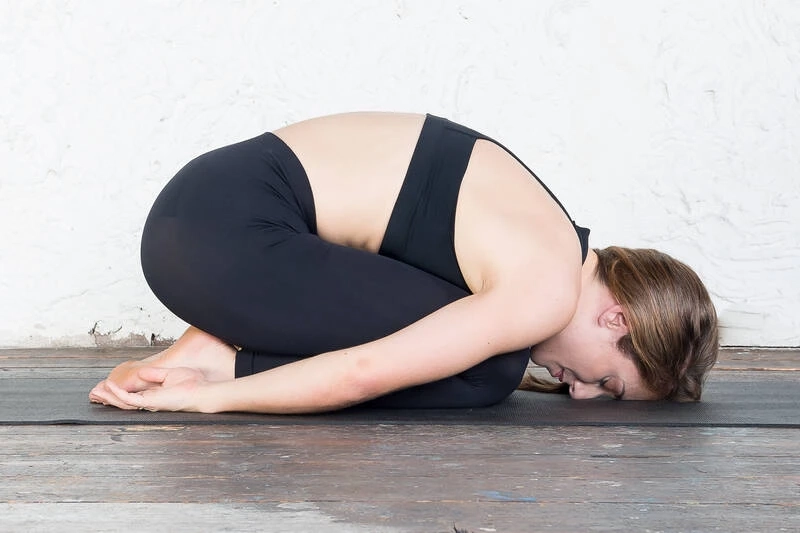Eka Pada Rajakapotasana comes from the Sanskrit words and means “One-Legged King Pigeon” and “asana” means “pose”. It is an advanced seated back bending pose and an effective hip opener. The asana also improves the flexibility of the pelvis and groin region. It also involves the twisting of the torso, adding more extreme flexibility. Pigeon pose offers lots of variations, and this is one of the advanced postures.
This posture allows you to go deeper. Even if you are quite ready to take on the final posture, you can try out the possibilities. However, the Mermaid posture is an advanced posture which you should practice under trained yoga experts. You need to have open hip joints and a larger range of motion, to get into the posture. If you strain your hip flexors unnecessarily, you may injure your flexors.
There is debate surrounding the One-legged Pigeon pose and the Mermaid pose, though. Apparently, both look similar to one another. However, the main difference is that, in the Mermaid pose, your body faces side wards and you open the hips like scissors. In the One-legged Pigeon, you face in front. Experts say that the Mermaid pose is the prep before the One-legged Pigeon pose.
How To Do The Mermaid Pose?
You can start from the Downward-Facing Dog pose or Adho Mukha Svanasana. It is the simplest way. Bring your right knee between your hands, as if you are preparing for a lunge. Slowly take your right ankle near your left wrist. And, instead of putting the foot down on the ground, you must lay your legs on the ground, so that the right knee touches the floor. The right shin may be aligned towards the left hip, or can be parallel to the mat. The left leg should be stretched back, and must lie flat on the floor. The left foot must point backwards. Keep padding under the right side of the hip. Once you are seated in the Pigeon pose, you need to take on the advanced stance. Slowly, bend the other leg, and try to bring the foot towards the body. Then, take your left hand back and try to grasp the left foot. Then, slide the left foot into the inner forearm, and hook it into the crook of your inner elbow. Inhale and raise the right hand upwards. Bend the right hand at the elbow and try to grasp the left hand. Ground yourself by drawing your tailbone towards the ground. You have to point the hips and shoulders forward. To release yourself from the pose, go back to the Downward-Facing Dog pose, and relax a bit, before repeating the same sequence on the other side.Tips To Practice Mermaid Pose With Ease
While practicing this advanced asana, it is absolutely important for you to focus and align.
The more the distance between your perineum and the front heel, the deeper you will be able to go into the pose. Your front foot must be flexed, to protect your knee. You have to use the strength of your legs to lift your spinal cord. You should always practice this asana, while keeping the comfort factor of your body in mind. Avoid the most common mistakes, like pushing your backbend. If you force it, you can injure yourself. You also need to warm up sufficiently, before you can do this posture.Modifications and Variations
If you feel any sort of pain or stiffness in your lower back or neck, you should ease the pose a little bit. You can try a few of the modifications listed below.
If you are unable to hook your back foot on the crease of your elbow, you can use a yoga strap. Loop the strap around the back foot, and hold both the ends with the top hand. You can keep the other hand on your thigh. If the full backbend is too stressful for you, the top hand can be kept on the thighs. You can also use a folded blanket underneath the front folded leg. Your front shin should be parallel to the edge of the mat.How To Prepare For The Mermaid Pose?
You can try out a few asanas, before you can finally do the Mermaid pose. The first pose, which you should try out is the Downward Facing Dog. After you are done with it, you can also do the low lunge yoga pose.
Benefits
This asana has tremendous benefits on the overall health of an individual. You should learn more about them.
It acts as a hip opener. The blood circulation in the hip region also improves. The pose gives a very deep stretch to the thighs, groin, and hips. It also strengthens the reproductive organs. It strengthens the pelvis. This asana will help in opening up the body and its joints, so that you become flexible enough to not face any injuries. The positioning and movements in this asana also stimulates the abdomen. It also reduces cardiovascular risk factors. It opens the heart chakra. The spine is activated throughout the practice, which leads to the activation of the chakras. It improves communication and self-expression.Contraindications
If you have any sort of injury in the pelvis, groin, ankle, shoulders, or knees, you should avoid doing this asana. If you are in your later stages of pregnancy, you must avoid this asana. If you have low blood pressure or high blood pressure, or any other cardiac issue, you should avoid this asana. If you suffer from Sciatic nerve condition, it will be better for you to avoid this asana.Conclusion
You must ensure to practice the posture initially under the supervision of trained experts. This is an advanced level asana, which you can do after you have practiced, the Pigeon Pose, and the Resting Pigeon Pose. Most people make the mistake of doing this posture, when the hips haven’t yet opened. Do hip openers, and then attempt this posture.
Source :- https://shivayogaashram.com/blog/eka-pada-rajakapotasana-or-one-legged-king-pigeon-pose-mermaid-pose/



